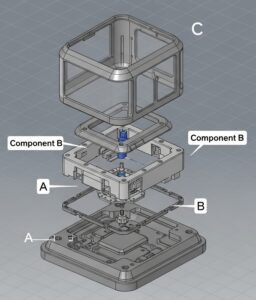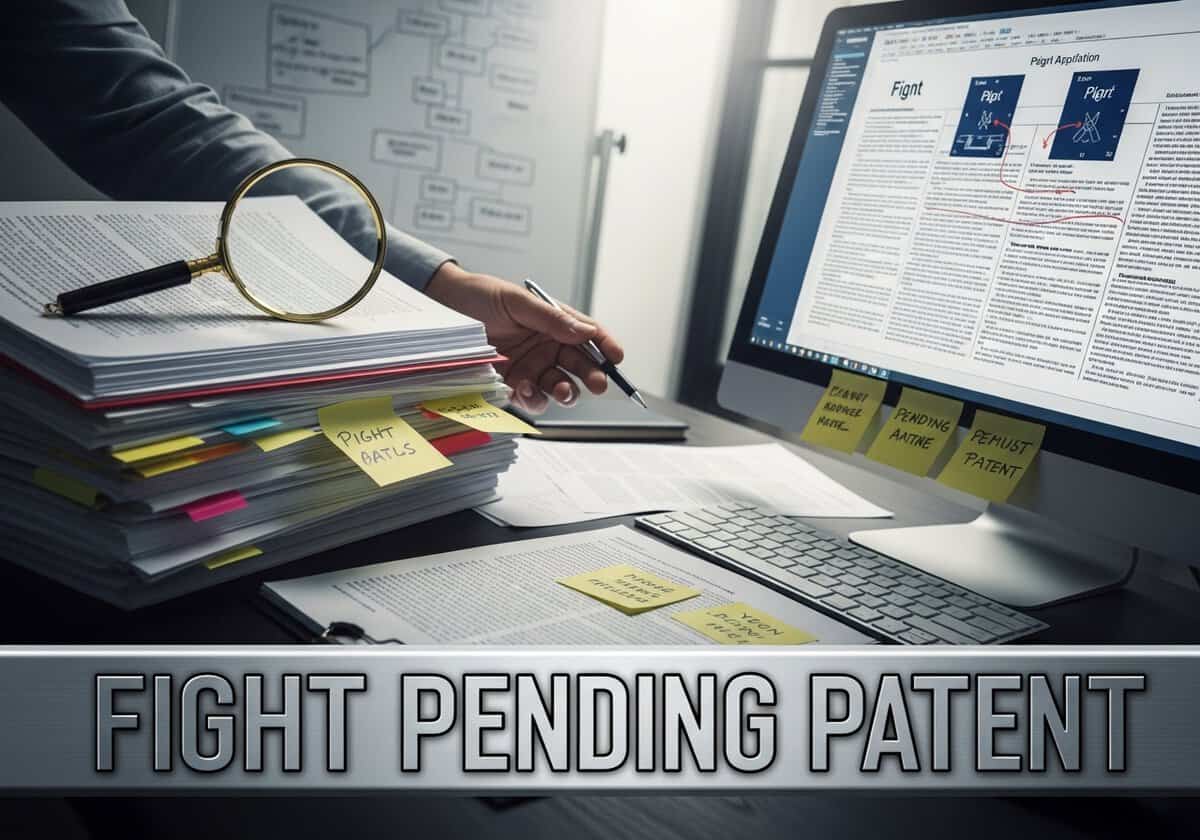A competitor’s pending patent application is often viewed as a distant threat, a legal issue to be addressed only if a patent is granted. This passive stance is a significant mistake. The period when an application is under examination by a patent office is a unique window for action and fighting a pending patent. During this time, the competitor’s claims are not yet fixed, their arguments are exposed in public records, and the final outcome is far from certain.

This is not a time to wait, but a time to gather intelligence and prepare a response.
A company can actively shape the examination process and prepare a robust defense against a future patent. This involves dissecting the application’s prosecution history to identify weaknesses, submitting prior art to the examiner to block or narrow the claims, and developing non-infringing product alternatives.
Here is a detailed breakdown of the 3 possible approches against pending patents:
Monitoring and Intelligence Gathering

This is the most fundamental step. You need to know exactly what the competitor is trying to protect and how successful they are being.
Track the application status: use public databases like the USPTO’s Public PAIR (Patent Application Information Retrieval) or the European Patent Register to monitor the application’s entire “prosecution history.” This allows you to see every document filed by the applicant and every “Office Action” sent by the patent examiner.
Analyze the claims: the claims, not the general description, define the legal scope of the potential patent or pending patent. Scrutinize them to understand the precise boundaries of the invention. Pay close attention to how the claims are amended during examination, as they often become narrower to overcome rejections.
Analyze the examiner’s rejections: the examiner’s rejections are a roadmap to the application’s weaknesses. If the examiner is rejecting the claims based on specific prior art, you know exactly what the competitor is struggling to differentiate their invention from.
Expert tip: create a “prosecution history estoppel log.” Instead of just passively reading the file history, actively document every argument the applicant makes to the examiner to overcome a rejection. Specifically, record any statement that distinguishes their invention from the prior art. For example, if they argue, “Our invention succeeds because our widget is circular, whereas the prior art widget is square,” log that precise statement. This log becomes your most powerful defensive tool if the patent ever grants.
Under the legal doctrine of prosecution history estoppel, an applicant cannot later argue that their claims should cover subject matter they explicitly surrendered during examination. Your log will provide a pre-built, powerful argument to defeat any attempt by the competitor to stretch their claim scope to cover your product under the doctrine of equivalents.
2. Proactive and Offensive Actions
While the application is pending, you can take direct or indirect action to influence the outcome.
Conduct a prior art search: perform your own exhaustive search for patents, publications, or products that existed before the competitor’s filing date. This can include other pending patents also. If you find better prior art than the examiner has found, you can use it to your advantage.
File a third-party submission: most patent offices have a formal process allowing third parties to submit prior art to the examiner. In the U.S., this must be done before the later of 6 months after publication or the first Office Action on the merits. This is a powerful, anonymous (or non-anonymous) way to provide the examiner with ammunition to reject the claims, potentially preventing the patent from ever being granted or forcing its claims to be significantly narrowed.

Designing products to strategically navigate patent claims to minimize infringement risk. Design around the claims: this is the most common engineering response. With a clear understanding of the claims, you can design your product to specifically avoid infringing them. For example, if a claim requires steps A+B+C, a product that only performs A+C may not infringe. Since the claims are still in flux, this requires ongoing monitoring, but it is a direct way to mitigate future risk.
Develop and file your own patents: create your own intellectual property around the competitor’s technology. You can file patents on improvements or alternative solutions. This creates a strong defensive position and can be used as leverage for future cross-licensing negotiations if their patent is eventually granted.
Expert tip: submit prior art to the patent office not just as a list of references, but accompanied by a meticulously prepared claim chart. A claim chart is a table that breaks down the competitor’s published claims, element by element, in one column. In the adjacent column, you provide pinpoint citations, quotes, and figures from the prior art references that show where each and every one of those elements is disclosed. This “spoon-feeds” the rejection argument to the examiner, making their job incredibly easy.
An examiner is far more likely to use art that is presented in such a clear, compelling, and structured format than to wade through a long list of submitted patents. This dramatically increases the probability that the competitor’s claims will be rejected or significantly narrowed.
Expert tip: in a patent war, a well-funded company can strategically leverage the protracted nature of legal proceedings to defend against a competitor’s blocking patent by engaging in a “never-ending court case” strategy. This involves initiating various legal challenges, such as validity challenges against the blocking patent (e.g., through inter partes review at the patent office or counterclaims in litigation), or by filing multiple, complex infringement lawsuits that require extensive discovery and expert testimony. The objective is to create significant delays, increase the competitor’s legal costs, and tie up their resources, thereby diminishing the commercial value of their blocking patent.
This strategy can buy the defending company crucial time to develop workarounds, negotiate a more favorable settlement, or even wait for the blocking patent to expire, ultimately neutralizing its threat through attrition and strategic procrastination.
3. Defensive and Strategic Preparation
You should also prepare for the possibility that the patent will be granted.

Obtain a Freedom-to-Operate (FTO) opinion: if your product appears to overlap with the pending claims, engage a patent attorney to provide a formal FTO opinion. This analysis assesses the risk that your product would infringe if the patent were to grant. A well-reasoned opinion of non-infringement can be a critical defense against charges of willful infringement, which can lead to triple damages in a lawsuit.
Identify...
You have read 44% of the article. The rest is for our community. Already a member? Log in
(and also to protect our original content from scraping bots)
Innovation.world community
Login or Register (100% free)
View the rest of this article and all members-only content and tools.
Only real engineers, manufacturers, designers, marketers professionals.
No bot, no hater, no spammer.
Related Readings
- Prior art searches: techniques for identifying existing patents and publications to strengthen arguments against a pending patent.
- Freedom to Operate (FTO) analysis: assessing the risk of infringing on existing patents or pending patent when launching a new product.
- Reverse engineering: analyzing a product to understand its design and functionality, which can inform patent challenges.
- Intellectual property strategy: developing a comprehensive strategy to protect your own innovations while contesting others’ patents.
- Legal frameworks and patent law: familiarity with patent laws and legal precedents that could impact the outcome of a patent and pending patent dispute.
- Open innovation models: exploring open innovation as a way to leverage external ideas and technologies while avoiding patent conflicts.
- Technology transfer and licensing: understanding the processes for negotiating licenses or transferring technology to avoid patent infringement.
Glossary of Terms Used
Freedom to Operate (FTO): a legal assessment determining whether a product, process, or technology can be developed, manufactured, or sold without infringing on existing intellectual property rights held by others.
Unique Selling Point (USP): a distinctive feature or benefit that sets a product or service apart from competitors, aimed at attracting customers by addressing specific needs or preferences.
United States Patent & Trademark Office (USPTO): federal agency responsible for granting patents and registering trademarks in the United States, promoting innovation and protecting intellectual property rights. It examines applications, issues patents, and maintains a database of registered trademarks.


























